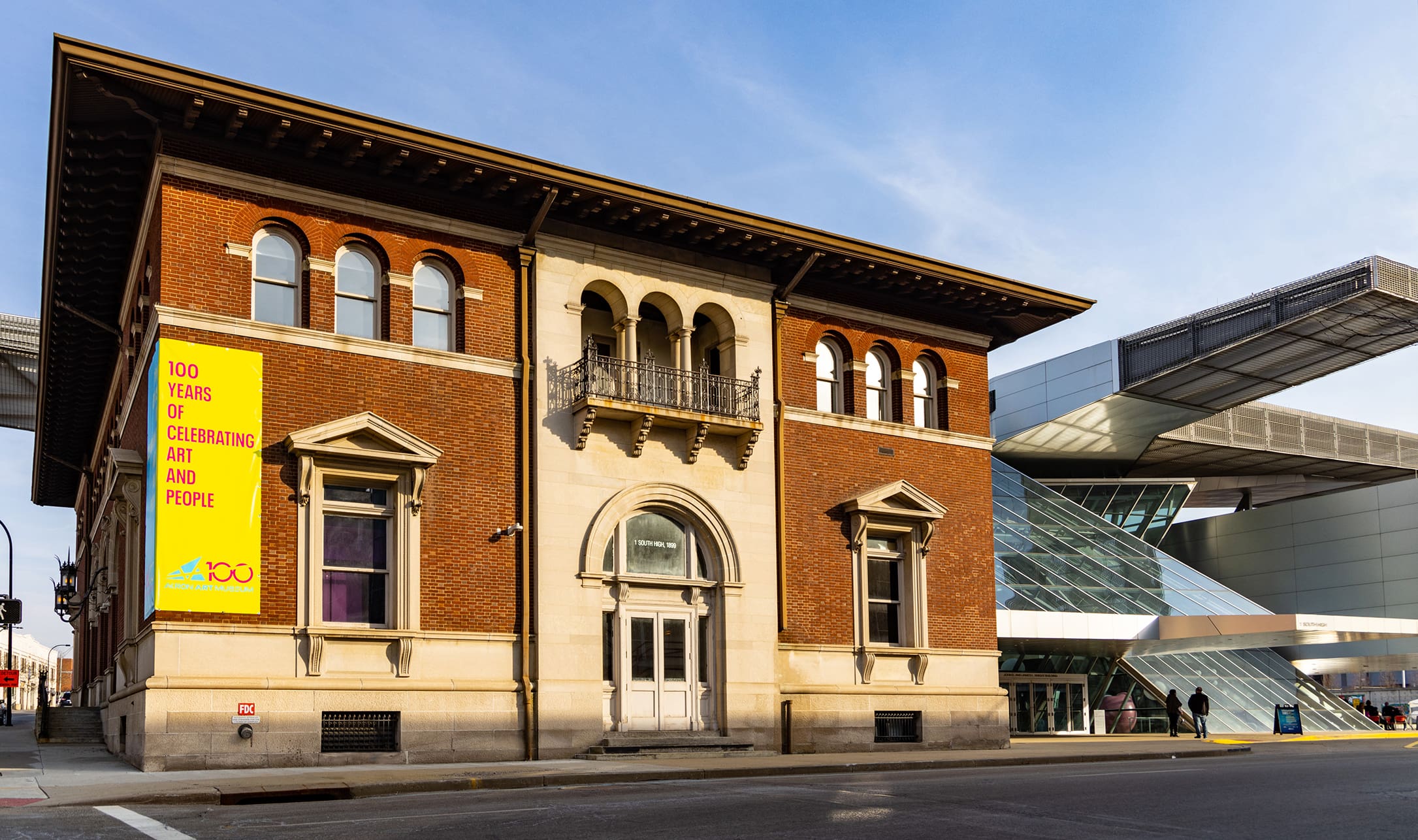Mission
The Akron Art Museum invites all people to enrich their lives through modern and contemporary art.

History
Volunteers were the sole staff until 1924, when city support made it possible to hire a professional director. The Great Depression tightened finances and ended City funding, forcing the Institute to again rely entirely on volunteers from 1931 to 1945. It functioned — much of that time in borrowed spaces — as an art center, offering classes and exhibiting mostly local artists. The collection was small, eclectic — containing archeological artifacts and decorative as well as fine art — and composed entirely of gifts. In 1937 the Institute moved into its first permanent home, a historic mansion. Just four years later, a disastrous fire destroyed the building and much of the collection, threatening the Institute’s existence.
It arose after World War II, phoenix-like, from the ashes with a professional staff and a new focus: fine art and design. Strengthening the fine art collection became a goal, leading to the first purchases of art. To educate the general public and encourage collecting, major loan exhibitions were organized, including contemporary design shows that garnered national attention. A professional school emphasizing the design arts was established. In 1950, the Institute moved back to where it had begun, the former public library, although this time it renovated and occupied the entire building.
In the mid-1960s, a re-examination of the Institute’s mission began. Over the next fifteen years, the Institute was transformed from a school and art center into a museum. When the school closed in 1965, fine art became the Institute’s primary emphasis. The goal of forming a distinguished comprehensive collection was replaced with a more specialized focus, exhibiting and collecting art produced from 1850 to the present. This focus was, and remains, unique in the region. In October 1980 the importance of collecting as part of the mission was sealed by a name change. “Akron Art Institute” became “Akron Art Museum.” The following year the Museum moved to another renovated historic downtown structure, the 1899 old post office building it still occupies.
Over the next quarter century, the Museum has continued to enrich the lives of those in Northeast Ohio and beyond through modern and contemporary art. Its nationally recognized collection was documented through the publication of collection catalogues. Three acquisitions endowments were created to ensure the collection’s future growth. A greatly enlarged general endowment provided increased, more stable funding, allowing the staff to undertake ambitious programs and exhibitions with national and even international impact. In 2007, its eighty-fifth year, the Museum more than tripled in size with the opening of the new John S. and James L. Knight Building, which adjoins the 1899 building. Spanning three centuries, like the Museum’s collection, together they symbolize the Museum’s dual role as preserver of the past and herald of the future.
Values Statement
We believe in the value of art and artists.
The Museum builds, studies, and shares our outstanding modern and contemporary collection of regional, national, and international art. We celebrate and collect emerging and established artists, invest in art that honors diversity and creativity, and preserve world-class art and architecture for future generations.
We believe in the power of museums to inspire and educate.
The Museum provides access to varied experiences that educate, inspire, and engage. Visitors are invited to learn, play, and grow while connecting with themselves and others. Experiences with art and artists are designed to explore the creative process and offer insight into how artists reflect human experience and culture across time and geography.
We believe in working with and for our community.
The Museum exists to serve the community and does so by building strong relationships through collaborative partnerships, constructive dialogue, and diverse representation.
We believe in fostering a culture of respect.
The Museum respects and values our stakeholders throughout all of our interactions. Welcoming others with a sense of belonging and valuing their contributions is of utmost importance.
We believe in accountability and continuous growth.
We strive for progress by living our values honestly and transparently as well as focusing on continuous growth through experience, collaboration, and introspection.
Statement of DEAI
The Akron Art Museum welcomes all people. We are committed to valuing diversity, fostering equity, and creating accessible and inclusive experiences with art and community where everyone can feel a sense of pride and belonging. We acknowledge that the Museum’s history has been shaped by past biases and inequities; the effects of which remain with us today. However, we believe that the arts have the power to both reckon with the past and make way for a better future. Through our actions, the Museum seeks to embrace and reflect the voices of all.
Land Acknowledgement
This is the traditional land of many diverse nations, including the Ohio Seneca and Cayuga, the Lenni Lenape (Delaware), the Miami, the Shawnee, the Wyandot (Wendat), the Odawa (Ottawa) and the Ojibwe Nations. It was these Indigenous People whose cultures, lifestyles, spiritual beliefs, and traditions shaped this land. The Akron Art Museum serves the community within this same place. Native history is American History and we acknowledge the Museum is indelibly intwined with indigenous exploitation and dispossession. The Akron Art Museum pays respect to the native forebearers of this land, honoring the roles indigenous communities have historically held and continue to hold in shaping the future of our shared home. We commit to the continuous processes of education in Native arts, relationship building with and among Indigenous Peoples, offering community space with which to share thought, dialogue and art, and concerted shifts toward sustainability and environmental stewardship initiatives.
